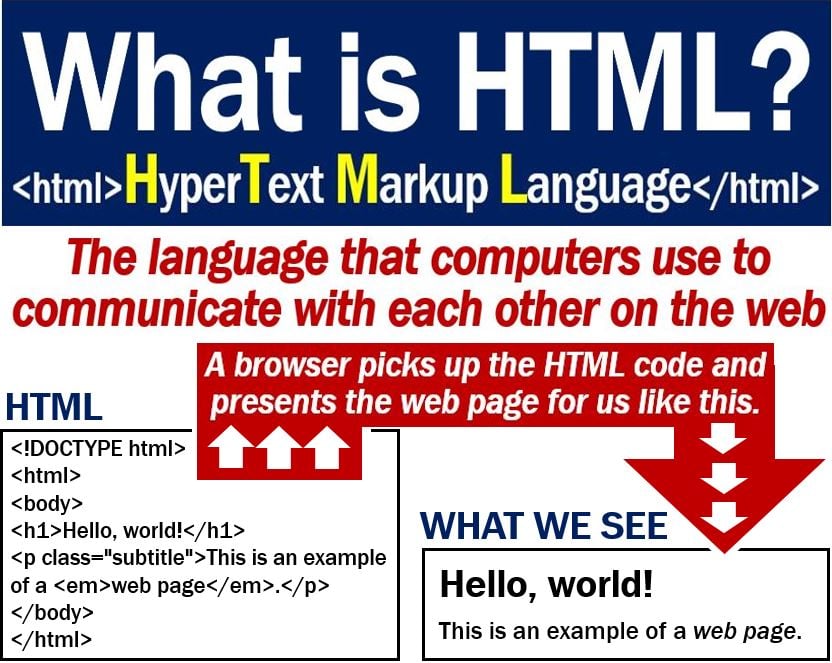HTML or HyperText Markup Language is the computer language we use to create websites or web applications. It is a code that helps us communicate with others on the Web. More specifically, it helps computers communicate with other computers. When we use HyperText Markup Language, we add ‘tags‘ to the text to create the structure. For example, if we add the tag ’em,’ it means that the word or phrase will be in italics.
Hypertext refers to the hyperlinks that a web page contains. Hyperlinks are links that take the online visitor from a hypertext, image, or button to somewhere else.
A hyperlink could take the visitor to another part of the web page, or another web page in the same website. It might also take the visitor to a completely different website.
A markup language is a computer language we use. It uses tags to define elements in a document. Markup language is human-readable rather than typical programming syntax, i.e., technical gobbledygook.
When we ‘tag’ and add ‘attributes’ to text files, we determine their color, font, and hyperlink effects. They also determine where graphic images appear and how big they are.
Techopedia.com says the following regarding Hypertext markup language:
“Hypertext markup language is the major markup language used to display Web pages on the Internet.”
“All HTML is plain text, meaning it is not compiled and may be read by humans.”
The limits of HTML
When computer experts designed HyperText Markup Language, they did not create it for today’s Web. It was simply a markup language with severe limitations regarding design and control.
We use several different technologies to work around these limitations. For example, CSS is one such technology. CSS stands for Cascading Style Sheet.
With CSS, we can describe how HyperText Markup Language elements appear on the screen of a computer. In fact, CSS can save a lot of work by controlling the layout of many different web pages simultaneously.

HTML short history
Physicist Tim Berners-Lee, a CERN contractor, proposed and prototyped ENQUIRE in 1980. ENQUIRE was a system for CERN scientists to use and share files or documents.
CERN, in Switzerland, is a European research organization that operates the world’s largest particle physics laboratory. CERN stands for Conseil Européen pour la Recherche Nucléaire (European Council for Nuclear Research).
Berners-Lee wrote a memo proposing an Internet-based hypertext system in 1989. He specified HTML and wrote the software for the browser and server in 1990.
In that same year, together with CERN systems engineer Robert Cailliau, they requested funding from CERN. However, CERN did not formally adopt the project.
However, despite not having CERN’s formal backing, Berners-Lee and Cailliau continued working together on the project.
In 1991, Berners-Lee wrote a document which he called HTML Tags. This is the first publicly-available description of HyperText Markup Language. The document described the eighteen elements that comprised the initial, relatively simple HTML design.
During the following decades, HyperText Markup Language evolved, i.e., there were several updates or new versions. First there was HTML 1.0, then 2.0, 3.0, 3.2, 4.01, and XHTML 1.0, and finally HTML5.
HTML5
HTML5 is the next generation of HyperText Markup Language. It allows for more interactivity and control.
As Gary Marshall explains in TechRadar.com, HTML5 is, in fact, three types of code:
– HyperText Markup Language, which provides the structure.
– CSS which deals with presentation.
– Javascript, which makes things happen.
The creators of HTML5 designed it to deliver virtually everything we’d want to do online. In other words, everything we’d want without needing browser plugins and other additional software.
In fact, HTML5 does everything from music to movies, and animation to apps. We can also use it to build amazingly complicated applications.
Video – What is HTML?
In this Howcast Tech Gadgets video, Daniel Davis explains what HyperText Markup Language is.
